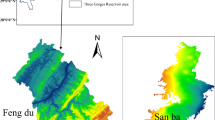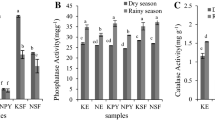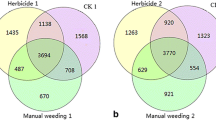Abstract
The re-establishment of natural species-rich heath lands on abandoned farmland is one of the main measures in soil erosion control in the Loess Plateau of China. So, it is important to understand how the vegetation and soil properties develop after land abandonment. The objective of this study was to determine how physico-chemical properties, microbial biomass, and enzyme activities changed for abandoned farmland with an age sequence of 0, 1, 5, 7, 10, 15, 20, 25, 30, 40 and 50 years in Zhifanggou watershed (8.27 km2), Shaanxi Province, NW China. The results of this study indicate that species succession after land abandonment in the Zhifanggou watershed on the Loess Plateau resulted in a significant improvement in soil chemical and microbiological properties. Soil organic C, total N, available N and K, soil microbial biomass C, N and P, as well as alkaline phosphatase, catalase, saccharase, and cellulase activity increased with time since plantation establishment increased. In contrast, soil bulk density, pH, and polyphenol oxidase activity decreased after farmland abandonment. Urease and α-amylase decreased until 15 years at the early phase of species succession, and then increased. However, there was no significant change in total P and available P during the restoration. Results only implied the tendency that the herbage was developing toward shrub. Although secondary succession plays an important role which improved soil properties after farmland abandonment, the values of these parameters were still much lower than native forest in 50 years. Thus, vegetation recovery after farmland abandonment in a semi-arid environment would be slow and the improvement of soil properties in the Loess Plateau is likely to require a considerably long period of time.




Similar content being viewed by others
References
Adema EB, Grootjans AP (2003) Possible positive-feedback mechanisms: plants change abiotic soil parameters in wet calcareous dune slacks. Plant Ecol 167:141–149
Badiane NNY, Chotte JL, Pate E, Masse D, Rouland C (2001) Use of soil enzyme activities to monitor soil quality in natural and improved fallows in semi-arid tropical regions. Appl Soil Ecol 18:229–238
Brookes PC, Landman A, Pruden G, Jenkinson DS (1985) Chloroform fumigation and the release of soil N: a rapid direct extraction method to measure microbial biomass nitrogen in soil. Soil Biol Biochem 17:837–842
Campbell BM, Frost P, King JA, Mawanza M, Mhlanga L (1994) The influence of trees on soil fertility on two contrasting semi arid types at Matopos, Zimbabwe. Agrofor Syst 28:159–172
Cao C, Jiang D (2008) Soil chemical and microbiological properties along a chronosequence of Caragana microphylla Lam. plantations in the Horqin sandy land of Northeast China. Appl Soil Ecol 40:78–85
Cao CY, Jiang DM, Alamsa, Luo YM, Kou ZW (2000) Ecological processes of vegetation restoration of Caragana microphylla in the sand fixing area. Chin J Appl Ecol 11:349–354
Cao CY, Jiang DM, Luo YM, Kou ZW (2004) Stability of Caragana microphylla plantation for wind protection and sand fixation. Acta Ecol Sin 24:1178–1185
Clements FE (1916) Plant succession: an analysis of the development of vegetation. Carnegie Institute of Washington Publication No. 242, Washington, DC
Dai QH, Liu GB et al (2007) Dynamics of soil water stable aggregates and relationship with soil properties on abandoned arable land in Eroded Hilly Loess Plateau. J Soil Water Conserv 21:61–65
Dick RP, Myrold DD, Kerle EA (1988a) Microbial biomass and soil enzyme activities in compacted and rehabilitated skid trail soils. Soil Sci Soc Am J 52:512–516
Dick RP, Rasmussen PE, Kerle EA (1988b) Influence of long-term residue management on soil enzyme activity in relation to soil chemical properties of a wheat-fallow system. Biol Fertil Soils 6:159–164
Editorial Committee (1996) Soil physical and chemical analysis description of soil profiles. Standards Press of China, Beijing
Frankenberger WT Jr, Dick WA (1983) Relationships between enzyme activities and microbial growth and activity indices in soil. Soil Sci Soc Am J 47:945–951
Guan SY (1986) Soil enzyme and its research approaches. China Agriculture Press, Beijing, pp 260–367
Institute of Soil Science, Chinese Academy Science (ISSCAS) (1978) Physical and chemical analysis methods of soils. Shanghai Science Technology Press, Shanghai, pp 7–59
Jiang Y, Zhang YG, Liang WJ, Wen DZ (2005) Profile distribution and storage of soil organic carbon in an aquic brown soil as affected by land use. Agric Sci Chin 4:199–206
Kèfi S, Rietkerk M, Alados CL, Pueyo Y, Papanastasis VP, ElAich A, de Ruiter PC (2007) Spatial vegetation patterns and imminent desertification in Mediterranean arid ecosystems. Nature 449:213–217
Lesschen JP, Cammeraat LH et al (2008) Development of spatial heterogeneity in vegetation and soil properties after land abandonment in a semi-arid ecosystem. J Arid Environ 72:2082–2092
Liu XM, Zhao HL (1993) Comprehensive strategy for ecoenvironmental control in Horqin SandLand. Gansu Science and Technology Publishing House, Lanzhou, China, pp 88–115
Mariotte CA, Hudson G, Hamilton D et al (1997) Spatial variability of soil total C and N and their stable isotopes in an upland Scottish grassland. Plant Soil 196:151–162
McGill M, Gannon KR, Robertson JA, Cook FD (1986) Dynamics of soil microbial biomass and water soluble organic C in Breton L after 50 years of cropping to two rotations. Can J Soil Sci 66:1–19
Perucci P, Scarponi L, Businelli M (1984) Enzyme activities in a clay-loam soil amended with various crop residues. Plant Soil 81:345–351
Plaza C, Hernández D, García-Gil JC, Polo A (2004) Microbial activity in pig slurry-amended soils under semiarid conditions. Soil Biol Biochem 36:1577–1585
Powlson DS, Brookes PC, Christensen BT (1987) Measurement of soil microbial biomass provides an early indication of changes in total organic matter due to straw incorporation. Soil Biol Biochem 19:159–164
Rutigliano FA, Ascoli RD, De Santo AV (2004) Soil microbial metabolism and nutrient status in a Mediterranean area as affected by plant cover. Soil Biol Biochem 36:1719–1729
Saggar S, McIntosh PD, Hedley CB, Knicker H (1999) Changes in soil microbial biomass, metabolic quotient, and organic matter turnover under Hieracium (H. pilosella L.). Biol Fert Soil 30:232–238
Schimel JP, Weintraub MN (2003) The implications of exoenzyme activity on microbial carbon and nitrogen limitation in soil: a theoretical model. Soil Biol Biochem 35:549–563
Sinsabaugh RL, Moorhead D (1994) Resource allocation to extracellular enzyme production: a model for nitrogen and phosphorus control of litter decomposition. Soil Biol Biochem 26:1305–1311
Sinsabaugh RL, Carreiro MM, Repert DA (2002) Allocation of extracellular enzymatic activity in relation to litter composition, N deposition, and mass loss. Biogeochemistry 60:1–24
Soil Science Society of China (1999) Soil physical and chemical analysis. Agricultural Science and Technology, Beijing, pp 146–226
Speir TW, Lee R, Pansier EA, Cairns A (1980) A comparison of sulfatase, urease, and protease activities in planted and in fallow soils. Soil Biol Biochem 12:281–291
Tabatabai MA (1977) Effects of trace elements on urease activity in soils. Soil Biol Biochem 9:9–13
Vance ED, Brookes PC, Jenkinson DC (1987) An extraction measuring soil microbial biomass C. Soil Boil Biochem 19:703–707
Wang J, Fu B et al (2003) Analysis on soil nutrient characteristics for sustainable land use in Danangou catchment of the Loess Plateau, China. CATENA 54:17–29
Wei J, Zhou J et al (2006) Decoupling soil erosion and human activities on the Chinese Loess Plateau in the 20th century. CATENA 68:10–15
Wilson JB, Agnew ADQ (1992) Positive-feedback switches in plant communities. Adv Ecol Res 23:263–337
Wu J, Joergensen RG, Pommerening B, Chaussod R, Brookes PC (1990) Measurement of soil microbial biomass C by fumigation-extraction: an automated procedure. Soil Biol Biochem 22:1167–1169
Zhang JT, Chai BF, Chen TG (2000) A study on succession of plant community of abandoned croplands in Loess hills of western Shanxi Province. J Plant Resour Environ 23:67–74
Zhou GY (1981) Discussion on the boundary of warm temperature deciduous broad-leaf forest region in China. J Plant Ecol Geobot 5:302–307
Zhou QH, Wu ZB, Cheng SP et al (2005) Enzymatic activities in constructed wetlands and di-n-butyl phthalate (DBP) biodegradation. Soil Biol Biochem 37:1454–1459
Zhou ZC, Shangguan ZP, Zhao D (2006) Modeling vegetation coverage and soil erosion in the Loess Plateau Area of China. Ecol Model 198:263–268
Zhu ZC (1983) The range of forest-steppe zone on the Loess Plateau of northern part in Shanxi Province. J Plant Ecol Geobot 7:122–131
Zou HY, Liu GB, Wang HS (2002) The vegetation development in North Ziwulin forest region in last fifty years. Acta Bot Boreal Occident Sin 22:1–8
Acknowledgments
This work was supported by The State Science and technology Support Project: CAS West Action: Experimental and Demonstration Study on Soil Conservation and Sustainable Ecosystem Rehabilitation on the Loess Plateau (KZCX2-XB2-05), 973 project: Assessment of impact on soil erosion and its indicators (2007CB407205), and the National Sciences Foundation of China Project (No. 40801094). Vegetation Configuration Optimized and Sustained Management Construction Technology on Loess Plateau (2006BAD09B03), The authors thank the members of the Ansai Research Station of Soil and Water Conservation, Chinese Academy of Sciences for technical assistance.
Author information
Authors and Affiliations
Corresponding author
Rights and permissions
About this article
Cite this article
Wang, B., Liu, G.B., Xue, S. et al. Changes in soil physico-chemical and microbiological properties during natural succession on abandoned farmland in the Loess Plateau. Environ Earth Sci 62, 915–925 (2011). https://doi.org/10.1007/s12665-010-0577-4
Received:
Accepted:
Published:
Issue Date:
DOI: https://doi.org/10.1007/s12665-010-0577-4




